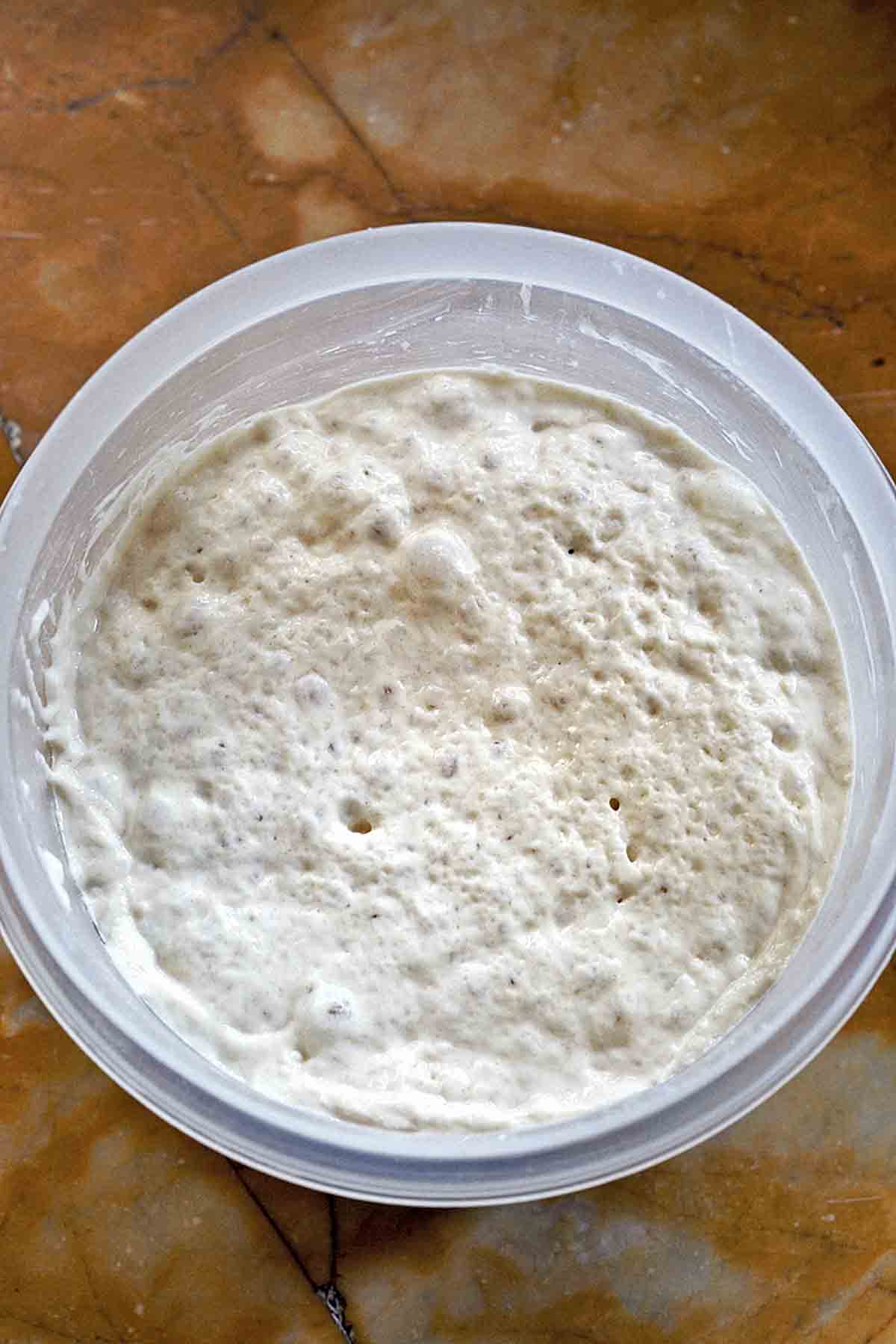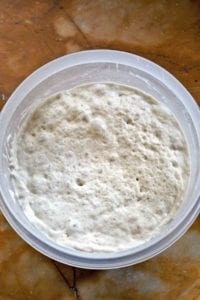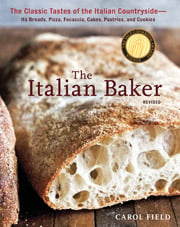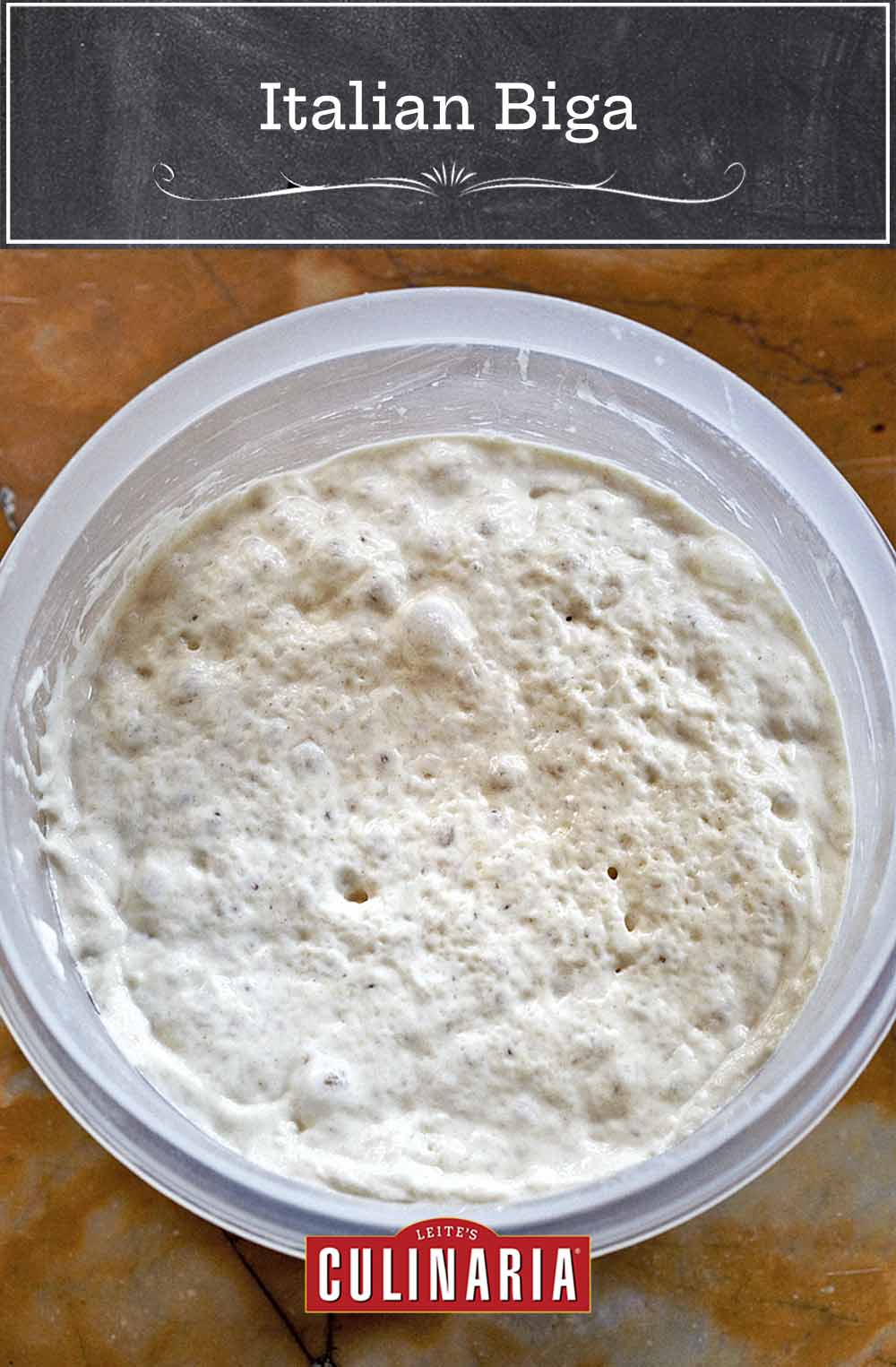
Many of the recipes for classic regional breads, such as this ciabatta recipe, begin with a starter dough made from small amounts of flour, water, and yeast allowed an initial fermentation. The starter, known as biga in Italy, or bighino when in small amounts, not only gives strength to what in Italy are weak flours, it also produces a secondary fermentation from which come the wonderful aroma, natural flavor, and special porosity of the final loaves and wheels of bread.
The important point about a biga is that the breads made with it develop a wonderful taste because their risings are long and bring out the flavor of the grain. Another benefit is that the loaves remain fresher and taste sweeter than those made with large amounts of commercial yeast.
In Italy, bakers use dough from the previous day’s baking to start a new dough. I keep some starter on hand at all times; by having it around, I can decide to make pane pugliese or ciabatta in the morning and have it for dinner that night. Because the first biga must come from somewhere, though, you may make it following the instructions below. It’s remarkable. It freezes very well and needs only about 3 hours at room temperature until it is bubbly and active again, or it can be refrigerated for up to 5 days.–Carol Field
LC Obliged to Biga Note
Behind each and every memorable bite of proper Italian bread we’ve daintily nibbled, hungrily inhaled, or otherwise somehow consumed, we have a biga to thank. So we’re feeling much obliged to Carol Field for this recipe. Nonna not included.

Italian Biga
Ingredients
- 1/4 teaspoon active dry yeast
- 1/4 cup warm water
- 3/4 cup plus 4 teaspoons water, preferably bottled spring water, at room temperature
- 2 1/3 cups unbleached all-purpose flour
- Vegetable oil, for the bowl
Instructions
- Stir the yeast into the 1/4 cup warm water and let stand until creamy, about 10 minutes.
- Stir the spring water into the creamy yeast mixture, and then stir in the flour, 1 cup at a time. If mixing by hand, stir with a wooden spoon for 3 to 4 minutes. If mixing with a stand mixer, beat with the paddle at the lowest speed for 2 minutes. If mixing with a food processor, mix just until a sticky dough forms.
- Transfer the biga to a lightly oiled bowl, cover with plastic wrap, and let rise at cool room temperature for 6 to 24 hours, until the starter is triple its original volume but is still wet and sticky. (The bakers I admire most advise 10 to 11 hours for the first rise, but others are very happy with the 24 hours it takes for dough to truly become yesterday’s dough, and if you like sour bread, allow your biga to rest for 24 to 48 hours or even 72 hours.)
- Cover and refrigerate or freeze the biga until ready to use. (If refrigerating the biga, use within 5 days. If freezing the biga, let it rest at room temperature for about 3 hours until it is bubbly and active again.) When needed, scoop out the desired amount of biga for your recipe and proceed. I strongly recommend weighing the biga rather than measuring it by volume since it expands at room temperature. If measuring by volume, measure chilled biga; if measuring by weight, the biga may be chilled or at room temperature.

Nutrition
Nutrition information is automatically calculated, so should only be used as an approximation.
Recipe Testers’ Reviews
This is a perfectly suitable starting point for most any bread which uses a starter. I bake bread several times a week and it’s nice to have this handy. Sometimes I add this to a bread dough which doesn’t call for a starter just for the added flavor.












How can I use biga in pizza dough, and with one Idaho baked potato diced?
Jose, we’ve never tried this, but you should be able to use biga in place of yeast in your pizza dough. There are many recipes online for partial biga doughs all the way up to 100% biga pizza doughs, depending on the type of pizza you’d like to make. As for the potato, perhaps use it for topping the pizza?
What is the difference between a biga and a sourdough starter?
Great question, Terra. Starter is made with only flour and water, and wild yeasts and bacteria that exist in the air become trapped in the mixture and cause fermentation to occur. If well maintained, you can keep a starter indefinitely. A biga, while also a preferment, is made with flour, water, and commercial yeast. It is typically firmer and drier than a starter, and is usually made a day (or a few days) before making your bread to add flavor and structure to the loaf. You can freeze biga, however, it is not typically maintained over a long period of time like a starter would be. Hope that helps.
Thank you!
Hi, I live in a warm city (room temp average is 35°C). I’m wondering if I can still rest the biga for 11-24 hours in my room? or should I reduce the resting time or rest it in the fridge? Thank you.
Whaan, that’s 95°F. Wow, you can you stand it that hot? That is much too warm for the biga. It needs to be around “room temperature,” but that doesn’t apply to you. Between 24°C and 27°C would be ideal. Your refrigerator is too cold. Is there someplace that you can manage the temperature?
If that is the case, I guess I need to bring the biga to my bedroom and rest it overnight when I have an air condition on. I did making biga and resting it overnight in normal room temp (around 32) once for a ciabatta recipe and my bread turn out tasting ok but the texture is quite gummy/shiny looking. I don’t know if this is because the temp of the room I rest the biga or not. Have you ever experience such texture?
Whaan, I’ve never had a gummy or shiny loaf. I have had loaves without big holes sometimes. The gumminess might be due to your oven. It might not be properly calibrated. All you need is a good oven thermometer.
Thank you for your advice. I will try to check the oven temp with thermometer again. However, I have baked normal yeast bread with no problem. I only experience this gelatinized gummy crumbs texture with the pre-ferment bread dough. So I first thought it might cause by the biga.
Whaan, it’s definitely a wetter and stickier dough, so it requires a longer baking time than traditional yeast breads. Still, your oven may be off. Also, are you weighing the ingredients or are you scooping them, specifically the flour? You could have a “light hand,” which means you’re not getting the full amount of flour. I always suggest using a scale to make sure everything is precise.
I think the main issue I have following this recipe is the wait time that leads to over-proofing and that acid air the blows out of the oven. I have learnt that going earlier is the way to go. More bounce in the oven. The other issue is shaping the dough….I don’t think you need to do it. Just my 5c worth.
Thanks, Ronnie.